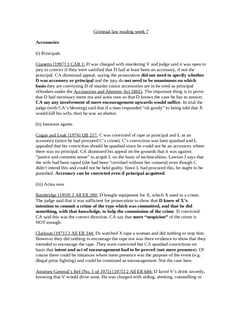Judgement for the case R v Camplin
KEY POINTS
In the standard of a “reasonable man,” reasonable adult should apply or be adjusted to account for the defendant's age. A critical consideration is the gravity of the provocation and the corresponding degree of self-control expected from a reasonable person.
In determining the appropriate standard, it is necessary to consider all circumstances surrounding the case. This includes an assessment of the evidence about a reasonable person's reaction to the provocation in question. The admissibility of such evidence becomes a crucial point for consideration.
In guiding the jury, providing a clear and specific direction is imperative. This direction should encompass the relevant provisions of the Homicide Act 1957 (5&6 Eliz.2, c. 11). The form and content of this direction to the jury will play a significant role in ensuring a fair and just evaluation of the case.
FACTS
In this particular case, a 15-year-old Chaplin ('Respondent') was charged with murder after using a chapati pan to fatally strike K. The Respondent's defense centered around the concept of provocation. According to their account, K had engaged in unwanted sexual activity despite the Respondent's resistance and then proceeded to laugh at him.
During the trial, the judge instructed the jury to carefully consider whether the provocation the Respondent experienced would have been enough to prompt an adult to react similarly under comparable circumstances reasonably.
The jury ultimately found the Respondent guilty of murder.
However, upon appeal, the Court of Appeal overturned the murder conviction and instead substituted it with a conviction of manslaughter.
JUDGEMENT
In dismissing the appeal by the Director of Public Prosecutions, the court affirmed that, under section 3 of the Homicide Act 1957, the jury had the authority to consider factors such as the accused's age and physical characteristics in assessing the seriousness of taunts and insults.
The court found fault with the judge's instruction to disregard the Respondent's age, leading to the rightful quashing of the murder conviction.
In a per curiam statement, the court provided guidance on directing the jury, emphasizing adherence to the language of section 3. It highlighted the need to consider the accused's characteristics influencing provocation gravity.
The court clarified that the question transcends mere provocation-induced loss of self-control, extending to whether the reaction aligns with the accused's.
The court ruled against admitting witness opinions on how a reasonable person would react to provocation, asserting the matter within the exclusive purview of the jury's opinion.
COMMENTARY
In this case, a 15-year-old named Chaplin faced a murder charge for using a chapati pan to fatally strike K, arguing provocation due to unwanted sexual activity and mockery by K. Despite an initial murder conviction, the Court of Appeal, dismissing the Director of Public Prosecutions' appeal, substituted it with manslaughter.
The court emphasized the jury's authority under the Homicide Act 1957, section 3, to consider age and physical characteristics when assessing the gravity of taunts. Criticizing the judge for disregarding Chaplin's age, the court justified quashing the murder conviction.
In a per curiam statement, the court advised aligning with section 3, highlighting the accused's characteristics in evaluating provocation. The court ruled against admitting witness opinions on reasonable reactions, emphasizing the jury's exclusive role. This case underscores legal intricacies in provocation, the significance of individual characteristics, and the jury's pivotal role in determining culpability.
ORIGINAL ANALYSIS
A boy was raped and killed his attacker.
In directing on provocation, the judge directed that the jury must consider whether the provocation was enough to make a “reasonable man” (not a boy of the defendant’s age) react in the way he did.
He was convicted of murder.
CA held that the jury were entitled to take age into account and hence the conviction was substituted for one of manslaughter. HL dismissed the prosecution’s appeal.
Lord Diplock
Says that a “reasonable man” doesn’t strictly mean the reasonable man. It means in fact what is reasonable for the person depending on age, sex, etc. The law does not require women to act like “reasonable men”.
Diplock says that subjective characteristics can be used to take into account the gravity of provocation to each individual, but everyone is expected to exercise self control of a reasonable man (the implication here being that any reasonable man may be provoked into violence by being raped).
RELATED CASES
For Further Study on R v Camplin
Need instant answers? Our AI exam tutor is here to help.
Ask questions 🙋 Get answers 📔 It's simple 👁️👄👁️
Our AI is educated by the highest scoring students across all subjects and schools. Join hundreds of your peers today.
Get StartedRelated Product Samples
These product samples contain the same concepts we cover in this case.
| Criminal Law | Defences Short Notes (28 pages) |
| Criminal Law | Homicide Notes (20 pages) |

 Since 2010, Oxbridge Notes has been a trusted education marketplace, supplying high-quality materials from top achievers at universities like Oxford, Cambridge, LSE, Harvard, and Yale.
Since 2010, Oxbridge Notes has been a trusted education marketplace, supplying high-quality materials from top achievers at universities like Oxford, Cambridge, LSE, Harvard, and Yale.